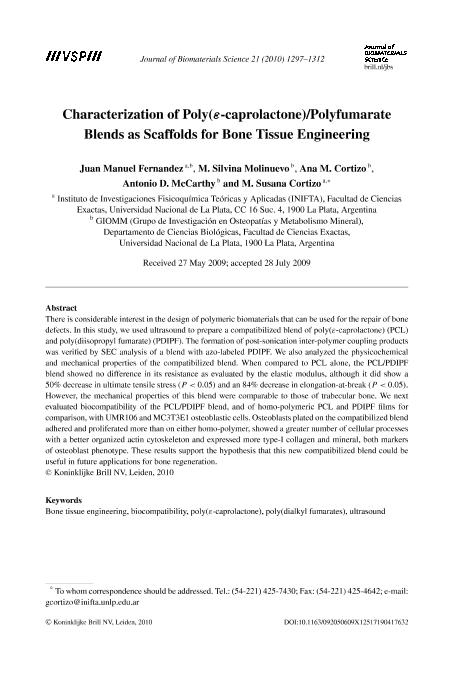Artículo
Development of an osteoconductive PCL-PDIPF-hydroxyapatite composite scaffold for bone tissue engineering
Fernandez, Juan Manuel; Molinuevo, María Silvina ; Cortizo, Maria Susana
; Cortizo, Maria Susana ; McCarthy, Antonio Desmond; Cortizo, Ana María
; McCarthy, Antonio Desmond; Cortizo, Ana María
 ; Cortizo, Maria Susana
; Cortizo, Maria Susana ; McCarthy, Antonio Desmond; Cortizo, Ana María
; McCarthy, Antonio Desmond; Cortizo, Ana María
Fecha de publicación:
06/2011
Editorial:
John Wiley & Sons Ltd
Revista:
Journal Of Tissue Engineering And Regenerative Medicine
ISSN:
1932-6254
Idioma:
Inglés
Tipo de recurso:
Artículo publicado
Clasificación temática:
Resumen
Hydroxyapatite (HAP)-containing poly-å-caprolactone (PCL)/ polydiisopropyl fumarate (PDIPF) composite (Blend) was developed as an alternative for bone tissue engineering. The physicochemical, mechanical and biocompatibility properties of these composites were evaluated using two osteoblast-like cell lines (UMR106 and MC3T3E1) and compared with the blend without HAP and PCL/HAP films. The increment in the elastic modulus and the decrease in the elongation-at-break of Blend-HAP suggest that the mechanical properties of the HAP-scaffolds have improved significantly. The addition of HAP to both PCL and Blend, significantly improves the cell biocompatibility and osteogenicity of the scaffolds. Evidence for this notion is based in several observations: a) HAP-Polymer increases proliferation of osteoblastic cells, b) HAP included in the blend increases the ALP expression in UMR106 cells, c) HAP-Blend increases the type-I collagen production in both cell lines, and d) higher levels of the osteogenic transcription factor Runx-2 were detected when MC3T3E1 osteoblasts were induced to differentiate and mineralize on HAP-polymer scaffolds. In conclusion, a novel biocompatible HAP-Blend composite with uniform dispersion of semi-nano HAP particles and good inter-phase compatibility has been prepared successfully. The development of HAP-Blend composite, with improved physical, mechanical and osteoinductive properties may be potentially used in bone tissue engineering applications. fumarate (PDIPF) composite (Blend) was developed as an alternative for bone tissue engineering. The physicochemical, mechanical and biocompatibility properties of these composites were evaluated using two osteoblast-like cell lines (UMR106 and MC3T3E1) and compared with the blend without HAP and PCL/HAP films. The increment in the elastic modulus and the decrease in the elongation-at-break of Blend-HAP suggest that the mechanical properties of the HAP-scaffolds have improved significantly. The addition of HAP to both PCL and Blend, significantly improves the cell biocompatibility and osteogenicity of the scaffolds. Evidence for this notion is based in several observations: a) HAP-Polymer increases proliferation of osteoblastic cells, b) HAP included in the blend increases the ALP expression in UMR106 cells, c) HAP-Blend increases the type-I collagen production in both cell lines, and d) higher levels of the osteogenic transcription factor Runx-2 were detected when MC3T3E1 osteoblasts were induced to differentiate and mineralize on HAP-polymer scaffolds. In conclusion, a novel biocompatible HAP-Blend composite with uniform dispersion of semi-nano HAP particles and good inter-phase compatibility has been prepared successfully. The development of HAP-Blend composite, with improved physical, mechanical and osteoinductive properties may be potentially used in bone tissue engineering applications. fumarate (PDIPF) composite (Blend) was developed as an alternative for bone tissue engineering. The physicochemical, mechanical and biocompatibility properties of these composites were evaluated using two osteoblast-like cell lines (UMR106 and MC3T3E1) and compared with the blend without HAP and PCL/HAP films. The increment in the elastic modulus and the decrease in the elongation-at-break of Blend-HAP suggest that the mechanical properties of the HAP-scaffolds have improved significantly. The addition of HAP to both PCL and Blend, significantly improves the cell biocompatibility and osteogenicity of the scaffolds. Evidence for this notion is based in several observations: a) HAP-Polymer increases proliferation of osteoblastic cells, b) HAP included in the blend increases the ALP expression in UMR106 cells, c) HAP-Blend increases the type-I collagen production in both cell lines, and d) higher levels of the osteogenic transcription factor Runx-2 were detected when MC3T3E1 osteoblasts were induced to differentiate and mineralize on HAP-polymer scaffolds. In conclusion, a novel biocompatible HAP-Blend composite with uniform dispersion of semi-nano HAP particles and good inter-phase compatibility has been prepared successfully. The development of HAP-Blend composite, with improved physical, mechanical and osteoinductive properties may be potentially used in bone tissue engineering applications. å-caprolactone (PCL)/ polydiisopropyl fumarate (PDIPF) composite (Blend) was developed as an alternative for bone tissue engineering. The physicochemical, mechanical and biocompatibility properties of these composites were evaluated using two osteoblast-like cell lines (UMR106 and MC3T3E1) and compared with the blend without HAP and PCL/HAP films. The increment in the elastic modulus and the decrease in the elongation-at-break of Blend-HAP suggest that the mechanical properties of the HAP-scaffolds have improved significantly. The addition of HAP to both PCL and Blend, significantly improves the cell biocompatibility and osteogenicity of the scaffolds. Evidence for this notion is based in several observations: a) HAP-Polymer increases proliferation of osteoblastic cells, b) HAP included in the blend increases the ALP expression in UMR106 cells, c) HAP-Blend increases the type-I collagen production in both cell lines, and d) higher levels of the osteogenic transcription factor Runx-2 were detected when MC3T3E1 osteoblasts were induced to differentiate and mineralize on HAP-polymer scaffolds. In conclusion, a novel biocompatible HAP-Blend composite with uniform dispersion of semi-nano HAP particles and good inter-phase compatibility has been prepared successfully. The development of HAP-Blend composite, with improved physical, mechanical and osteoinductive properties may be potentially used in bone tissue engineering applications.
Archivos asociados
Licencia
Identificadores
Colecciones
Articulos(CCT - LA PLATA)
Articulos de CTRO.CIENTIFICO TECNOL.CONICET - LA PLATA
Articulos de CTRO.CIENTIFICO TECNOL.CONICET - LA PLATA
Articulos(INFINA)
Articulos de INST.DE FISICA DEL PLASMA
Articulos de INST.DE FISICA DEL PLASMA
Citación
Fernandez, Juan Manuel; Molinuevo, María Silvina; Cortizo, Maria Susana; McCarthy, Antonio Desmond; Cortizo, Ana María; Development of an osteoconductive PCL-PDIPF-hydroxyapatite composite scaffold for bone tissue engineering; John Wiley & Sons Ltd; Journal Of Tissue Engineering And Regenerative Medicine; 5; 6; 6-2011; 126-135
Compartir
Altmétricas



